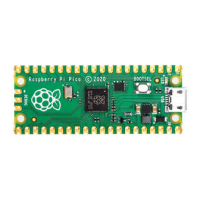Chapter 5. Flash Programming with
SWD
Serial Wire Debug (SWD) is a standard interface on Cortex-M-based microcontrollers, which the machine you are using
to develop your code (commonly called the host) can use to reset the board, load code into flash, and set the code
running. Raspberry Pi Pico exposes the RP2040 SWD interface on three pins at the bottom edge of the board. The host
can use the SWD port to access RP2040 internals at any time, so there is no need to manually reset the board or hold
the BOOTSEL button.
Figure 6. The SWD
port is labelled at the
bottom of this Pico
pinout diagram. The
ground (GND)
connection is required
to maintain good
signal integrity
between the host and
the Pico. The SWDIO
pin carries debug
traffic in both
directions, between
RP2040 and the host.
The SWCLK pin keeps
the connection well-
synchronised. These
pins connect to a
dedicated SWD
interface on RP2040,
so you don’t need to
sacrifice any GPIOs to
use the SWD port.
On a Raspberry Pi, you can connect the Pi GPIOs directly to Pico’s SWD port, and load code from there. On other
machines you will need an extra piece of hardware — a debug probe — to bridge a connection on your host machine (like
a USB port) to the SWD pins on the Pico. One of the cheapest ways to do this is to use another Pico as the debug probe,
and this is covered in
Appendix A.
This chapter covers how you can connect your machine to Raspberry Pi Pico’s SWD port, and use this to write programs
into flash and run them.
TIP
If you use an IDE like Visual Studio Code (Chapter 7), this can be configured to use SWD automatically behind the
scenes, so you click the play button and the code runs, as though you were running native code on your own
machine.
NOTE
You can also use SWD for interactive debugging techniques like setting breakpoints, stepping through code
execution line-by-line, or even peeking and poking IO registers directly from your machine without writing any
RP2040 software. This is covered in
Chapter 6.
5.1. Installing OpenOCD
To access the SWD port on a microcontroller, you need a program on your host machine called a debug translator,
which understands the SWD protocol, and knows how to control the processor (two Cortex-M0+s in the case of
Getting started with Raspberry Pi Pico
5.1. Installing OpenOCD 18

